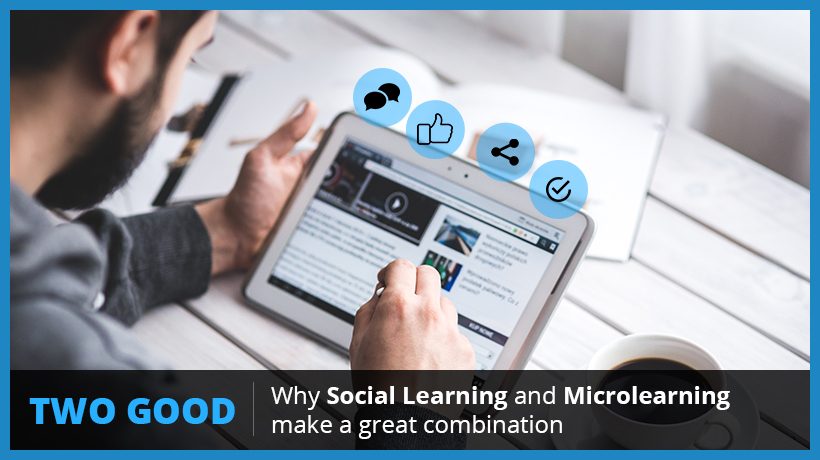
The new hybrid work paradigm has spawned a need from employees – learning resources to support their workflow. Learning in the flow of work (LIFOW) aims to support that need. In this article, I highlight how you can leverage it to your advantage.
What Is Learning in the Flow of Work ?
In today’s highly competitive instant-messaging era, the flow of work is relentless. Between meeting project deadlines, responding to text messages and emails, and attending meetings, employees have few opportunities to enhance existing skills and learn new ones. To learn, the learners do not want to step out of work – they want to be able to access just-in-time learning resources when they want to learn – within their workflow.
LIFOW (a concept by Josh Bersin) advocates that for continuous learning to happen, the learning resources must be available within the learner’s workflow.
Why Is Learning in the Flow of Work a Must-use Strategy in 2022?
It’s a proven fact that employees learn best in an environment where they expect to apply that learning – at work. The 70:20:10 rule also underscores how L&D directly contributes to on-the-job performance.
As 2022 rolls on, and more employers embrace the hybrid work model, the distinction between where work starts and where it ends is likely to further fade. Employees are likely to work “after hours,” and co-mingle personal chores during “work hours.” As a result, hybrid workplaces are changing the traditional definition of “workflow.”
In this new paradigm, unless organizations embrace LIFOW strategies, both employees and L&D teams will face a challenge setting defined “learning time.”
- Because LIFOW puts learning at the crossroads of working and learning, it’s an ideal strategy to support corporate learning in the new hybrid workplace.
- In LIFOW, learning integrates itself within the natural flow of work, so employees won’t have to carve out a specific time to learn.
Do Learners Want Learning in the Flow of Work Now?
The short answer: Yes!
Based on data collected between 2017 (pre-pandemic) and 2020 (post-pandemic), synchronous learning, which includes On-the-Job Training (OJT) and On-the-Job Coaching (OJC), dropped from 86% to 77%.

These data sets also reveal that almost 80% of learners prefer at least one mode of sync learning – and the results show why that’s the case – Almost 50% of those learners, who received some form of sync learning, found their training to be highly effective. Compared to that, less than 30% of those who experienced non-synchronous learning found their training to be effective.
Seeing the effectiveness of learning in the flow of work, it’s therefore not surprising that though only 31% of learners indicated OJT as a preference, nearly 35% of them received training through that mode. OJT, which includes elements of LIFOW, was the second most popular (32%) training delivery method, after Instructor-Led Training (57%)
How Does Learning in the Flow of Work Happen?
In a non-LIFOW model, learning typically happens well in advance of its actual application. Usually, by then, because of the “Forgetting Curve,” most learners scramble to recall how to apply past knowledge to a present work situation. LIFOW happens at the point of need. As employees encounter a task-related challenge at work, they endeavor to learn more about how to address it. This sets them off on a learning journey that aligns with their workflow. The just-in-time nature of LIFOW ensures better knowledge transference into the real world.
What Design Considerations Should You Adopt to Enable Learning in the Flow of Work ?
Because LIFOW is a strategy that caters to an anytime, anywhere model of learning, the traditional “push” approach to learning won’t work. L&D teams will fail if they decide where, what, and how employees must learn.
Instead, include the following pillars as part of your LIFOW design:
- Accessible: Designing learning content to be highly accessible ensures hybrid employees, across the spectrum, can more readily access and consume that content.
- On-demand: Include responsive designs into your course structures. This facilitates on-demand consumption, anytime, anywhere, and on any device.
- Customized learning paths: Make sure your design caters to the learners’ ability to customize their own learning paths.
- Curated carefully: Ensure the design taps into uniquely curated content, preferably influenced by learner objectives.
Remember: The glue that holds these individual design considerations together is learner support. Ensure you design has adequate support structures for hybrid workforce learners when and where they need it.
How to Leverage LIFOW in Your Employee Training?
A good LIFOW program leverages multiple performance support and improvement dimensions:
- To drive deliberate practice: All formal trainings are time-constrained. LIFOW can leverage opportunities for employees to safely, without considerable risk, practice further and hone some skills that were introduced through formal training sessions.
- To reinforce learning: LIFOW can leverage opportunities for remote employees to continually review, revise, refresh, and reinforce skills and concepts learned during formal training.
- To offset the Forgetting Curve: Learners often forget “stuff” when there’s a lag between formal learning and instances where employees apply those skills to workplace challenges. As part of a LIFOW strategy, Just-in-Time (JIT) learning, featuring “How to” tools and other job aids, helps learners “remember.”
- To improve the application of learning on the job: Through extended training, employees learn performance improving knowledge. Learning in the flow of work strategies help translate that learning into the workforce.
- To teach new concepts and for skill building: In a hybrid workplace, where trainers, mentors, and supervisors may not always be available to assist employees when a need arises, LIFOW helps employees quickly acquire new skills in the moment of their need.
What Strategies Should You Adopt to Enable LIFOW?
A comprehensive LIFOW program involves implementing multiple strategies. Some of these include:
- Microlearning: Bite-sized (shorter) learning content is ideal for learning in the moment of need.
- mLearning: Leveraging small footprint content, which is mobile-friendly, enables learning anytime and anywhere.
- VBL/IVBL: Both Video Based Learning (VBL) and Interactive Video Based Learning (IVBL) facilitate on-the-job learning by acting as Performance Support Tools (PSTs). They also serve as great Microlearning resources as part of broader learning in the flow of work strategies.
- PSTs/Job aids: In busy workplaces, especially in hybrid environments, pausing work to learn isn’t an option. Performance Support Tools (PSTs) and other job aids (PDF documents, “How to…” videos, Cheat Sheets, Templates) are great LIFOW strategies.
- Content curation: The hallmark of an effective LIFOW program is to quickly empower employees with the learning they need just in time. Having well-curated, efficiently indexed, and intuitively collated content can further the goals of any LIFOW strategy.
- Social learning: The 70:20:10 rule tells us that not all learning happens through formal training, or only in the workplace. Learning in the flow of work examples, where learners learn outside of the workplace from peers and groups of social networks, work well for hybrid learners.
- User Generated Content (UGC): LIFOW can leverage UGC to aid employees to tap into experiences of colleagues and peers.
To get the most out of any LIFOW program, it’s vital to underpin these strategies with feedback loops that allow a two-way exchange of views between L&D teams and learners. It also helps to implement frequent check-ins with learners, especially in a hybrid (remote) working environment. Finally, because LIFOW is often time-sensitive, providing learners access to Subject Matter Experts (SMEs) can further cement the successful implementation of a FIFO strategy.
Let’s review some real-world learning in the flow of work examples to highlight the application of the concepts discussed above.
Examples of Learning in the Flow of Work
Here are a few learning in the flow of work examples that will help shed light on how LIFOW works in real life:
Learning in the Flow of Work Example #1: Sales Training
This course was designed to demonstrate how a sales employee should accurately identify a buyer’s needs in any interaction.
LIFOW support was provided through videos for quick access to key pointers that should be followed to achieve this goal.
- A Scenario Based approach was used to thread through the concepts.
- Videos and mini activities were used to create an immersive experience for the learner.
Learning in the Flow of Work Example #2: Internal Reporting
This course was designed for employees to understand a product registration tracking module available in the customer’s system.
LIFOW support was given through a detailed downloadable resource that they could reference at any point during their work.
- The main module covered the concept in detail.
- Downloadable resources were plugged in at relevant junctures to enable continuous performance in the flow of work.
- As and when the need to follow the process arises, the employees can access this resource on any device to fill in the gaps.

Learning in the Flow of Work Example #3: Safety Systems
The course was created for employees to review information on how to safeguard confidential information at any time – what forms a part of it and methods to safeguard the information.
LIFOW support was in the form of short and crisp pointers covered in the video available at their fingertips at any time of the day!
- A short video was used to explain the key concepts.
- The video could be accessed at any time to refresh the concepts, thereby targeting the Forgetting Curve.
- This standalone video emphasizes the need to safeguard confidential information, what forms a part of this confidential information and the methods to safeguard it.

Learning in the Flow of Work Example #4: Quality Assurance
A consulting firm required its employees to differentiate the key accounts from non-key accounts. This was to be done using a formula to calculate the scores for each account and compare it with the baseline score.
LIFOW support was provided as a cloud-based template that could be populated by the employees to calculate the scores and compare it with their baseline.
- The concepts are explained as a video within the module.
- A link to the template is provided for the employees to access and download it at their convenience.

Parting Thoughts
Not all on-the-job performance situations are learned during formal training. Neither do most employees remember what they’ve learned 12 months ago during a two-day training event. I hope the learning in the flow of work examples showcased above prove that when performance matters at the time and place of need, LIFOW helps bridge the knowledge gaps that would otherwise lead to subpar job outcomes.
Meanwhile, if you have any specific queries, do contact me or leave a comment below.
Read More
- eBook: eLearning Trends in 2022 – A Guide for Designing High-Impact L&D Programs for the Hybrid Workforce
- 5 Examples of Microlearning in Corporate Training that Boost Learner Engagement and Performance
- 3 Microlearning Strategies to Promote Learning in the Flow of Work
- How to Conduct an L&D Audit and Prepare a Strategic Plan for the Future
- Focus Areas for Preparing a Learning and Development Strategy for 2022
Reference
Training Industry, Inc. (2021). What Learners Want: Strategies for Training Delivery. Retrieved from https://trainingindustry.com/research/.








